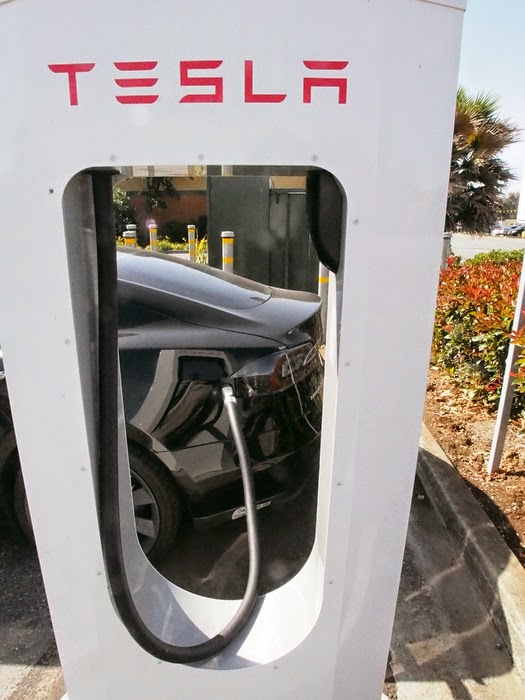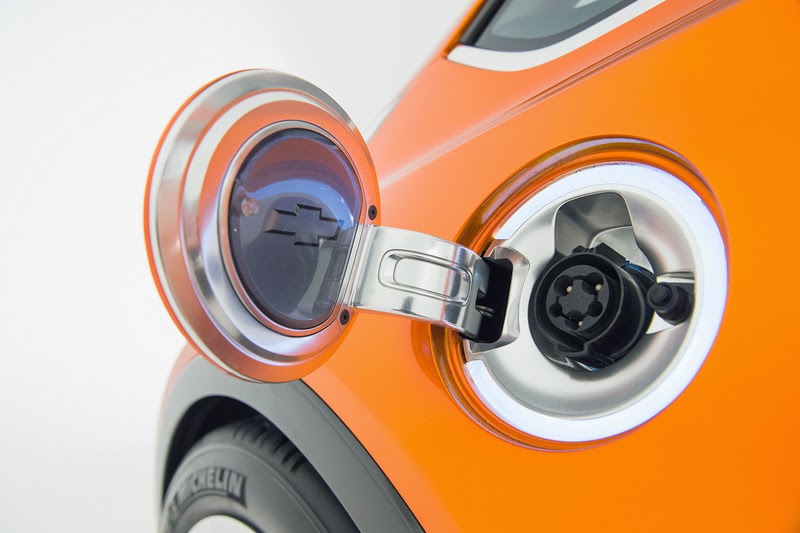Will the public charging networks be ready for the Chevy Bolt and other 200+ mile range electric cars due around 2017? It’s exciting that GM has unveiled the Chevy Bolt electric concept car. Assuming they can successfully get it on the market, the 200+ mile range and $30,000 MSRP should be a game changer. But, will existing 50kw DCFC’s be sufficient for a 200+ mile range electric car?
Basic physics of electric cars tells us the Bolt will have at least a 60 kiloWatt-hour battery pack. By comparison the Tesla Model S comes in two models, the 60 kWh version has a 208 mile electric EPA range, while the 85 kWh version has a 265 mile EPA range.
How long will it take to recharge a 60 kWh battery pack from empty? A heck of a lot longer than the current crop of 24 kWh electric cars. Over twice as long.
Typical level 2 charging stations run at 6 kiloWatts, giving the 3-4 hour recharge time typically quoted today. With a 60 kWh pack a full recharge at 6 kiloWatts will require about 10 hours.
 The typical DC Fast Chargers run at 50 kiloWatts with some sites opting for lower power models to avoid demand charges or otherwise have a less expensive installation. The recharge time typically quoted is 30 minutes for an 80% recharge, for a 24 kWh electric car.
The typical DC Fast Chargers run at 50 kiloWatts with some sites opting for lower power models to avoid demand charges or otherwise have a less expensive installation. The recharge time typically quoted is 30 minutes for an 80% recharge, for a 24 kWh electric car.
A similar recharge time on a 60 kWh electric car, through the same charging equipment, will require over twice the time, or perhaps 1 1/4 hours for an 80% recharge. That’s not exactly a fast charge, is it?
Tesla Motors showed some foresight by building the Supercharger stations to run at a 100+ kW charging rate. Model S owners are now routinely taking long distance road trips using the SuperCharger network. A full recharge of an 85 kWh Model S takes about 1 hour for 265 miles of range.
Now that I’ve given you a bunch of numbers, let’s ponder what they mean.
The crop of Combo Charging System and CHAdeMO DCFC’s are, as I said, supporting a 50 kW charging rate. An 80 kW DCFC would recharge the Bolt in under an hour, and a 120 kW DCFC (the charge rate on the Supercharger network) would do the deed in a half hour or so. Will the charging network operators continue installing 50 kW equipment?
The charging networks are designing the infrastructure around a 30 minute per car turnaround time. A typical DCFC installation has 1 fast charger supplemented by a bank of level 2 charging stations. This arrangement works with a 30 minute or less charging time, but if each car takes 1+ hours the queuing time will be unacceptably long. Will the charging network operators continue designing the infrastructure this way?
I’ve long been of the opinion that 32 amp level 2 public charging service is not in the slightest bit future-proofed. Now that 200+ mile range electric cars are just around the corner, we see the first concrete validation of that opinion. While a 3-4 hour recharge time is barely acceptable at public charging stations, a 10 hour recharge time is unacceptable. This is a limitation of the typical on-board charger (6 kW) and the typical existing public charging station infrastructure (6 kW). The J1772 plug is capable of handling up to a 19 kW charging rate. Will the single phase AC on-board charging equipment switch to a higher charging rate? Will the charging station vendors start delivering higher power single phase AC stations?
In other words the charging infrastructure currently being built is inadequate for the cars that are just around the corner. That is, if you measure “adequate” or “pathetic” using the typical time for a full recharge.
Another measure of public charging infrastructure inadequacy is the utility of miles of range per hour of charging.
The rule of thumb says a 32 amp level 2 charging station at 6ish kW charging rate gives 25 miles of range per hour of charging. A 50 kW DCFC would give well over 100 miles of range per hour of charging. A 12 amp level 1 power outlet gives 5-7 miles of range per hour of charging.
These numbers are true whether the car has a 24 kWh or 60 kWh battery pack.
The current 6 kW charging stations will continue giving 25 miles of range per hour of charging to the coming crop of 200+ mile range electric cars. So long as car owners focus on the utility of range gained per hour of charging, they’ll be just as happy as they are today.
But – we know from the hundreds of parking lot conversations with the EV Curious, that question#2 is “how long does it take to recharge.” Or maybe it’s question#3, the order of the 5 typical questions does vary from questioner to questioner.
Anyway, the 2017 version of the EV Curious wannabe electric car driver will be negatively affected when the sales person says “10 hours”. That’s enough to make an EV Curious into an EV Won’t.
Therefore, for the project of electric vehicle adoption to continue the 2017 charging infrastructure needs to be a lot higher power than todays charging infrastructure.
- Highway design could decrease death and injury risk, if “we” chose smarter designs - March 28, 2015
- GM really did trademark “range anxiety”, only later to abandon that mark - March 25, 2015
- US Government releases new regulations on hydraulic fracturing, that some call “toothless” - March 20, 2015
- Tesla Motors magic pill to solve range anxiety doesn’t quite instill range confidence - March 19, 2015
- Update on Galena IL oil train – 21 cars involved, which were the supposedly safer CP1232 design - March 7, 2015
- Another oil bomb train – why are they shipping crude oil by train? – Symptoms of fossil fuel addiction - March 6, 2015
- Chevron relinquishes fracking in Romania, as part of broader pull-out from Eastern European fracking operations - February 22, 2015
- Answer anti- electric car articles with truth and pride – truth outshines all distortions - February 19, 2015
- Apple taking big risk on developing a car? Please, Apple, don’t go there! - February 16, 2015
- Toyota, Nissan, Honda working on Japanese fuel cell infrastructure for Japanese government - February 12, 2015

















